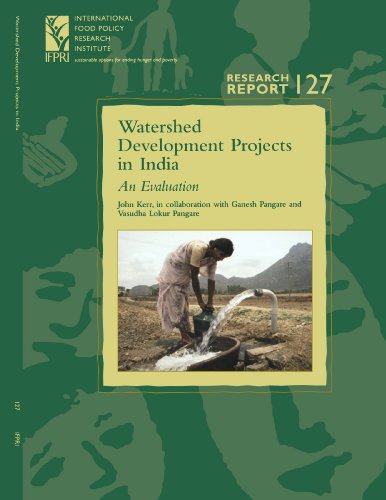Verwandte Artikel zu Watershed Development Projects in India: An Evaluation...
Watershed Development Projects in India: An Evaluation (Research Report 127 - International Food Policy Research Institute - IFPRI) (Research Report ... Food Policy Research Institute), 126,) - Softcover

Inhaltsangabe
The Green Revolution that transformed irrigated agriculture elsewhere in India had little effect in the rainfed, semi-arid regions. Agricultural productivity remained low, natural resources were degrading, and the people were poor. In the 1980s and 1990s, planners turned to watershed management to develop rainfed agriculture while conserving natural resources. By the late 1990s, India was spending US$500 million a year on watershed development projects. Strategies ranged from the purely technical to those that emphasized social organization. Little systematic analysis exists, however, on the success of the different approaches. This study, based on a survey of 86 villages in Andhra Pradesh and Maharashtra states, attempts to fill that information gap by evaluating the projects' relative success in raising agricultural productivity, improving natural resource management, and reducing poverty. In looking at the question of what approaches enable a project to succeed, it uses both quantitative and qualitative analysis to compare project and nonproject villages before and after the projects were implemented. The authors find that projects involving the villagers in planning and decisionmaking performed better than their technocratic, top-down counterparts, but projects that combined participation with sound technical input performed best of all. All projects faced difficulties in ensuring that poor people shared the benefits of watershed development.
Die Inhaltsangabe kann sich auf eine andere Ausgabe dieses Titels beziehen.
Reseña del editor
The Green Revolution that transformed irrigated agriculture elsewhere in India had little effect in the rainfed, semi-arid regions. Agricultural productivity remained low, natural resources were degrading, and the people were poor. In the 1980s and 1990s, planners turned to watershed management to develop rainfed agriculture while conserving natural resources. By the late 1990s, India was spending US$500 million a year on watershed development projects. Strategies ranged from the purely technical to those that emphasized social organization. Little systematic analysis exists, however, on the success of the different approaches. This study, based on a survey of 86 villages in Andhra Pradesh and Maharashtra states, attempts to fill that information gap by evaluating the projects' relative success in raising agricultural productivity, improving natural resource management, and reducing poverty. In looking at the question of what approaches enable a project to succeed, it uses both quantitative and qualitative analysis to compare project and nonproject villages before and after the projects were implemented. The authors find that projects involving the villagers in planning and decisionmaking performed better than their technocratic, top-down counterparts, but projects that combined participation with sound technical input performed best of all. All projects faced difficulties in ensuring that poor people shared the benefits of watershed development.
„Über diesen Titel“ kann sich auf eine andere Ausgabe dieses Titels beziehen.
EUR 21,23 für den Versand von USA nach Deutschland
Versandziele, Kosten & DauerNeu kaufen
Diesen Artikel anzeigenEUR 11,59 für den Versand von Vereinigtes Königreich nach Deutschland
Versandziele, Kosten & DauerSuchergebnisse für Watershed Development Projects in India: An Evaluation...
Watershed Development Projects in India (Research Report (International Food Policy Research Institute), 126,)
Anbieter: Revaluation Books, Exeter, Vereinigtes Königreich
Paperback. Zustand: Brand New. 104 pages. 10.75x8.25x0.25 inches. This item is printed on demand. Bestandsnummer des Verkäufers zk0896291294
Anzahl: 1 verfügbar
Watershed Development Projects in India: An Evaluation (Research Report 127 - International Food Policy Research Institute - IFPRI) (Research Report . Food Policy Research Institute), 126,)
Anbieter: Wonder Book, Frederick, MD, USA
Zustand: As New. Like New condition. A near perfect copy that may have very minor cosmetic defects. Bestandsnummer des Verkäufers H04B-01486
Anzahl: 1 verfügbar
